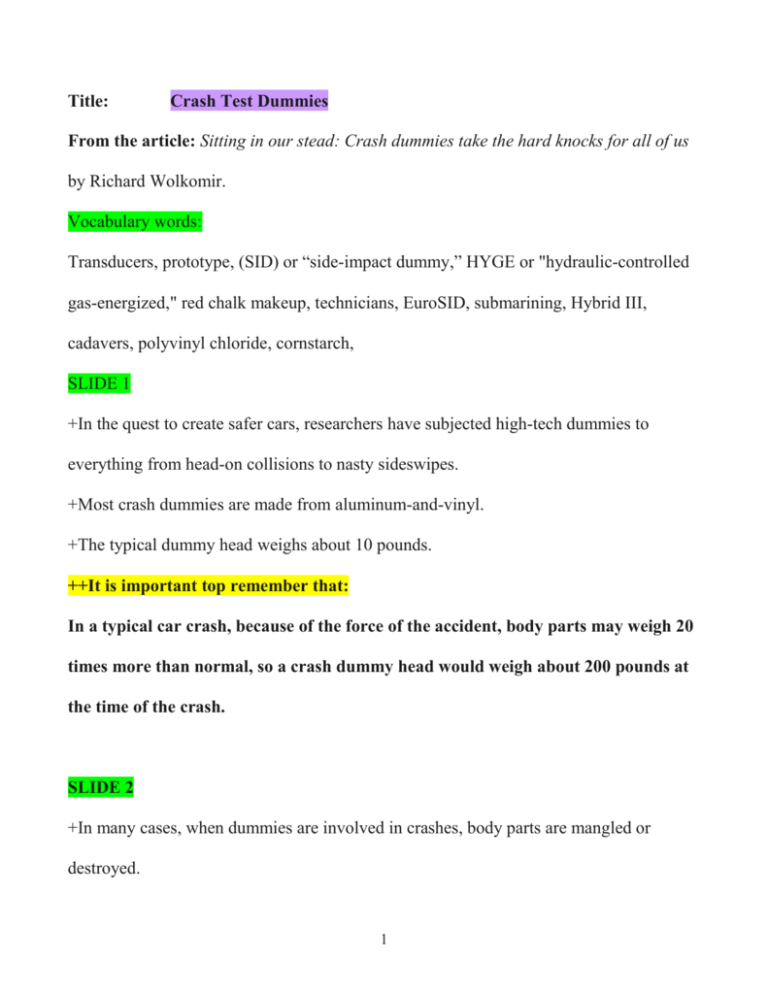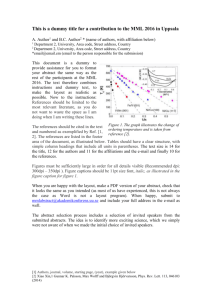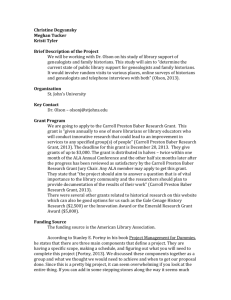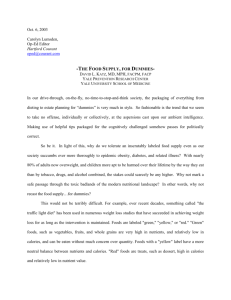Crash Test Dummies Lecture Notes
advertisement

Title: Crash Test Dummies From the article: Sitting in our stead: Crash dummies take the hard knocks for all of us by Richard Wolkomir. Vocabulary words: Transducers, prototype, (SID) or “side-impact dummy,” HYGE or "hydraulic-controlled gas-energized," red chalk makeup, technicians, EuroSID, submarining, Hybrid III, cadavers, polyvinyl chloride, cornstarch, SLIDE 1 +In the quest to create safer cars, researchers have subjected high-tech dummies to everything from head-on collisions to nasty sideswipes. +Most crash dummies are made from aluminum-and-vinyl. +The typical dummy head weighs about 10 pounds. ++It is important top remember that: In a typical car crash, because of the force of the accident, body parts may weigh 20 times more than normal, so a crash dummy head would weigh about 200 pounds at the time of the crash. SLIDE 2 +In many cases, when dummies are involved in crashes, body parts are mangled or destroyed. 1 +This is why carmakers like General Motors stock up on extra dummy heads, spare arms, torsos, legs and feet. +In fact, some car companies have dummy hospitals where Dummies go after a hard day at the office to get fixed up. +Dummies come in all shapes and sizes. ++You should remember that: the average "50th Percentile Male," is 5 feet 8 inches tall and weighs 170 pounds. +A typical female is about 5 feet tall and 110 pounds. +They also make children dummies that match kids’ ages of 6 months, 1, 3 and 6 years old. SLIDE 3 It is important to remember that Each dummy has sensors, called transducers, that detect the amount of impact on the human body. < Insert “transducers” here> +Dummies are just like us, their proportions exact, their transducers are just like our nerves. +They are often called: injury-measuring devices. 2 +They are just machines, but they look so much like us it is upsetting to see them take our hits. +They repeatedly crash dummies into walls to show what would happen to us. +General Motor engineers say 30 percent of their crashes are to make sure new cars meet federal safety regulations. +The rest are to work out bugs in prototype cars or equipment. +The purpose of saving lives using dummies can be costly. ++You should write this down in your notes: each dummy costs nearly $100,000. +Every year General Motors performs about 500 car crashes on purpose. +Other automobile companies demolish their cars, too. +They also use crash "sleds" to help researchers understand how cars can be made even safer. +A new type of dummy has been developed called SID ++An important fact about SID is that SID stands for "side-impact dummy," a specialist in sideways crashes into other cars. +SID's sensors measure the forces from a broadside crash exerts on a human body. SLIDE 4 Not only do car manufacturers use cars, but the also use powerful sleds to see the impact of car accidents. 3 +They use a sled call HYGE. HYGE stands for "hydraulic-controlled gas-energized," which describes how the sled operates. < Insert “hydraulic-controlled gas-energized” here> +A hydraulic ram shoots out from a 100-ton concrete block to give the sled a 3,000pounds-per-square-inch punch. +In response, the sled accelerates down 120-foot-long rails, rocketing from zero to 30 mph in six one-hundredths of a second about the blink of your eye. +After that, the sled is merely rolling to a stop. SLIDE 5 +On one typical test day, the car manufacture is testing a new air bag for front and side crashes. +As SID awaits the test, he is bathed in high-intensity light for the benefit of high-speed video cameras on the sidelines and the sled's two on-board movie cameras. +SID looks like a screen actor on a set. ++Technicians do three things when preparing a crash dummy for a test: 1. they check their lighting so they can capture every image of the accident. 2. they apply red chalk "makeup" to SIDs body that -will leave marks where SID's head and torso strike the simulated air bag. 4 3. Technicians use red laser beams to position the dummy. It must sit exactly the same in test after test. +This particular sled is rigged with a car door and window. +Nylon sacks represent the experimental air bag. +SID sits on a simulated car seat, sideways to the waiting ram. +During the set up SID sits peacefully, a thick umbilical cord of wires coming from the seat of his pants. +During the crash, 31 continuous measurements from SID's interior sensors will rush simultaneously through a cable into a waiting computer. +The computer will record an incoming stream of data 4,000 times during the two-fifthsof-a-second measurement interlude. +On this day, SIDs feet have been removed because in previous tests they stuck to the floor and slightly slowed the speed at which he rammed into the door. +Also, SID might feel deprived if he knew he had no arms, which would get in the way. +Yet, his designers did not omit arms in their calculations. +Once everything is ready, the set is cleared and red flashers signal that pressure is building in the ram. 5 +Technicians hurry behind a Plexiglas shield as the ram's operator, in a control booth above the concrete slab, conducts the countdown. +Wham! The sled rockets down the tracks and crashes. +SID jerks sideways. +In the sled that has stopped down the track, SID lies sprawled out, his head on the laboratory floor where it smacked. +The researchers ignore SID and instead race to the computer screen to view the video. +They hover around a video screen for an instant replay. +The researchers are studying a computer screen displaying the forces on SID's body at impact. +Eventually they will note precisely where the red chalk from SID's head and torso marked the air bag. SLIDE 6 +As technology becomes better, dummies evolve just like animals have evolved. +Their evolution has helped to save many lives. ++Test crash dummies have taught humans 2 important facts about car accidents: 1. Wearing Seat belts reduce serious injury and death by 42% 6 2. Adding airbags reduces the death rate and 10% +Early test crash dummies only measured front impacts. +Today’s dummies need to measure both front and side-impact, hence the use of SIDs. +A typical dummy has steel ribs covered with a vinyl-graphite composite to simulate the response of human ribs to a hit from the side. +In a crash, SID's sensors measure his sideways acceleration. +SID is currently the federal standard for ensuring that new cars meet side-impact crash regulations. +One of the first side-impact dummy was EuroSID, from government labs in Europe. < Insert “EuroSID” here> +But U.S. automakers say EuroSID's chest is too rigid so GM researchers, working with +Automotive Engineers, created BioSID - BioSID mimics the human body. +BioSID's newer sensors and flexing body better portray what happens to the human body in a side collision. +According to industry experts, SID's relatively crude instruments mainly reveal what a crash does to his bones. +BioSID, on the other hand, can give a better reading on the overall risk of internal organ injury. SLIDE 7 7 +When looking back at the first dummies that were ever developed, technology has come a long way. ++You should know that….The first modern, instrumented dummies, which came along just after World War II as test-pilot stand-ins. +In the beginning there was Parachute Man - that was in the late 1940s, when jet fighters first appeared. +Crash-test dummies were needed to test ejection seats, but the early dummy designers had no knowledge of how to build a human replica. +The early ejection-seat dummies were basically steel barrels with limbs and heads. It was the auto industry, starting in the 1950s, that started the dummies evolving. +With enactment of the National Highway Traffic Safety Act of 1966, dummy evolution took off. +Now the engineers were working on improving seat belts and air bags, which often exert complicated forces on a body. SLIDE 8 +GM took the lead in 1971, creating the Hybrid I dummy, which GM made available to the entire industry, a practice it has continued. +By 1976 researchers had produced the sophisticated Hybrid III, which will be the standard federal dummy after September 1, 1997, although it is already widely used. 8 +It is the most humanlike dummy so far, with major exceptions: Hybrid III's designers omitted ears, eyes, nose and mouth. +If you press the Hybrid III’s forehead, it like skin over a skull. +However, Hybrid III is highly sensitive machine. +Sensors in its neck (it moves just like ours), in its steel, vinyl-graphite-layered ribs (they deflect just like ours) and on down in its lower legs, measure everything from impact on the pelvis to knee shear and impact on the tibia, sending all the data to computers. ++Something else you should record in your notes is that: Safety engineers are now studying "submarining"—that happen when you wear your lap belt too high and you slide under it at impact, possibly injuring your abdomen. < Insert “submarining” here> +To work out anti-submarining belt designs, engineers gave Hybrid III a styrofoam abdominal insert that crushes and tells them the potential injuries to a human. +Hybrid III is still evolving. +For one thing, seat belts and air bags have reduced fatalities and upper-body injuries, with serious head injuries down substantially. +So researchers are looking at other dangers, like leg injuries. 9 +They are designing knee restraints and these changes require more leg instrumentation in the dummies. +The impact on body parts continues to advance… +Also in the early days, scientists used cadavers to see the impact of crashes. +These days bio-engineers also visit trauma clinics to learn from actual accident victims, + some cadaver research continues at universities. +Still, dummies remain mere contraptions. SLIDE 9 +How do they make the actual dummies? +For one technology plant in Michigan, where a small workforce manufactures most of the world's crash-test dummies--about 300 a year--from blocks of steel, aluminum and plastic goo. +They x-ray parts to check the shape and density of the aluminum bones to make sure they don't break prematurely in a crash. ++An important point to remember is that the skin is made from liquid polyvinyl chloride plastic. < Insert “polyvinyl chloride” here> +After the plastic bakes into skin of correct thickness, they use grinders and hot irons make it smooth. 10 +The bones of the neck are molded together with the metal vertebrae separated by rubber disks. +When finished, these dummies are shipped in coffin-like shipping boxes. +Many dummies must undergo tests to make sure that new cars meet federal standards. +For those measurements to be accurate, each dummy's sensor must be precisely calibrated. +That means the dummies must regularly undergo nasty physicals, including pounding in the chest with a 50 pound pendulum. +Their knees get smashed with federally specified weights. +They also have their heads dropped 14 inches to smack onto a table. +All that is to make sure the dummies' sensors and physical responses are correct. +Designers also are working on an air bag that unfurls from a chamber recessed below the steering wheel to prevent the driver's chest from coming too close. +In one test crash, when the countdown reached zero, a dummy plunged toward the steering wheel at 12 mph. +Just before the dummy hits, the air bag housed in the steering wheel bursts open, and the falling dummy is engulfed in a cloud of cornstarch. ++You should note that cornstarch is used as a lubricant in the bag. 11 SLIDE 10 +Because of dummies we are a safer society. In fact, they have already helped. +The U.S. fatality rate is about 40,000 per year, a disturbing figure. +The number of deaths per mile of travel is now more than 90 percent lower than it was in 1922 because of government regulation, improved occupant protection and more-crashworthy cars. +And dummies played a large part in all of this. +Eventually, dummies will lose their jobs. +Engineers are now testing on-screen computer dummies that crash virtual cars in the cyberworld. +Despite being virtual or real, dummies have a done a lot to improve saftey and save lives. Reference: Wolkomir, R. (July 1995). Sitting in our stead: Crash dummies take the hard knocks for all of us. Smithsonian, 26(4), 30-39. 12






